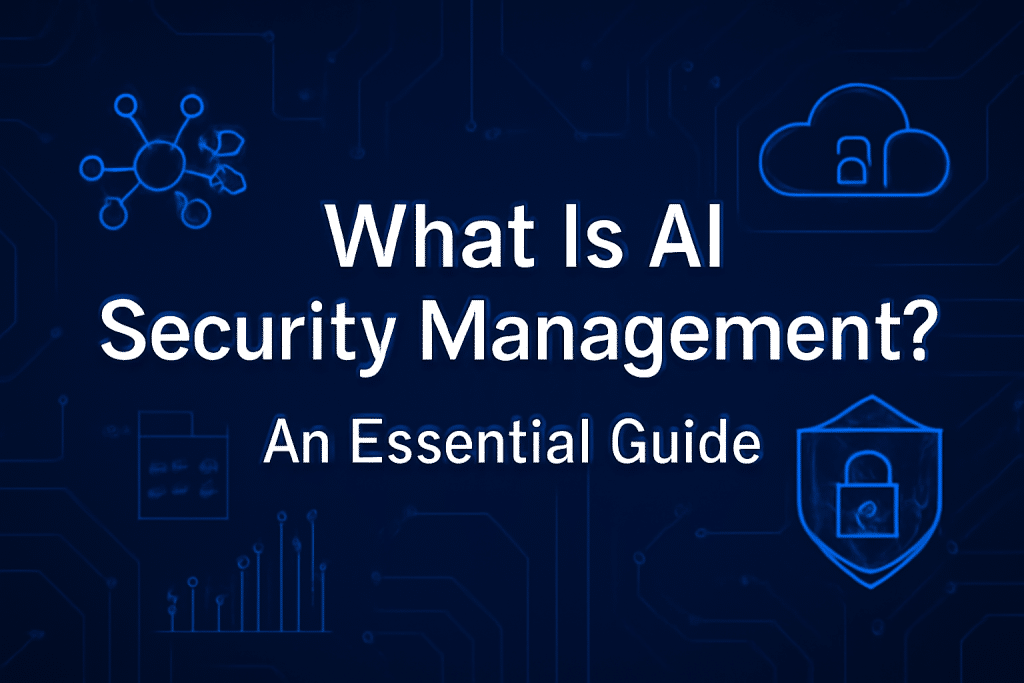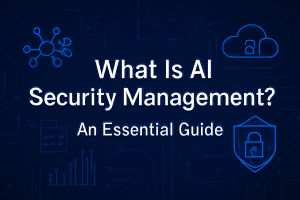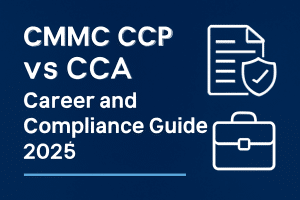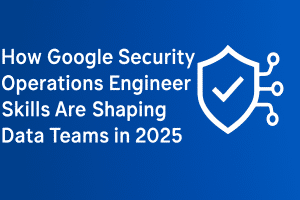Artificial intelligence now drives decisions, automates workflows, analyzes sensitive data, and influences outcomes inside every major enterprise. As AI systems become embedded in day-to-day operations, the security focus is shifting from protecting networks to governing intelligent behavior. Traditional controls alone cannot prevent model manipulation, data leakage, autonomous misfires, or subtle shifts in decision quality.
This is the moment where AI security management emerges—not as an extension of cybersecurity, but as a leadership discipline in its own right. If you are a CISSP, CISM, IT security manager, or enterprise security architect, this is the field you must now master.
This AAISM guide gives you a deep, practical, leadership-ready understanding of AI security management, built to outperform every existing explanation online.
What Is AI Security Management?
AI security management is the governance, protection, and assurance of artificial intelligence systems across their entire lifecycle—covering data pipelines, model behavior, automated decisions, and the real-world outcomes they influence.
It ensures that AI operates safely, ethically, transparently, and in alignment with organizational risk appetite.
Unlike traditional cybersecurity, which focuses on assets like networks and endpoints, AI security focuses on protecting:
- Training data and inference inputs
- Models, agents, and decision logic
- Model outputs and automated workflows
- Human-AI interactions
- Third-party AI integrations
- Organizational trust, compliance, and reputation
In short, AI security management ensures that every system powered by AI is reliable, auditable, and governed—not just technically secure.
Why AI Security Requires a Completely New Mindset
AI brings risks that are invisible in traditional security environments:
- An AI assistant can leak sensitive data without being “attacked.”
- A model can drift over time and make biased or harmful decisions.
- A prompt injection can alter an agent’s behavior instantly.
- A third-party vendor’s model can mishandle your data.
- A compromised training set can poison a model silently for months.
None of these would be caught by firewalls, SIEM alerts, or endpoint tools.
AI security management is the discipline that fills these gaps—ensuring the business does not accelerate innovation without matching it with accountability and safety.
Core Responsibilities of an AI Security Manager
The role blends strategy, governance, cybersecurity, and risk leadership. Below are the responsibilities expected from modern AI security leaders (far deeper than any competitor blog provides):
1. Govern AI Across the Entire Lifecycle
AI security starts long before deployment. You must oversee:
- Model design reviews
- Data sourcing and classification
- Model training and validation
- Output safety checks
- Deployment guardrails
- Continuous monitoring
- Decommissioning and audit trails
No model should move forward without structured approvals.
2. Secure Data Pipelines and Training Sources
Data is the “attack surface” of AI.
You must protect it from:
- Poisoning
- Leakage
- Unapproved data ingestion
- Policy violations
- Shadow data sets
Without data integrity, model integrity does not exist.
3. Protect Model Behavior and Output Reliability
Your responsibility extends to the decision quality of AI systems.
You evaluate:
- Prompt abuse
- Response unpredictability
- Bias and fairness deviations
- Hallucinations
- Jailbreak attempts
- Over-fitting and under-fitting
- Drift in accuracy over time
You are the gatekeeper preventing unsafe AI behavior from reaching real users.
4. Manage Model Access and Authorization
AI interfaces introduce new access risks:
- Agents can trigger unauthorized actions
- Non-technical staff can access sensitive capabilities
- LLMs can unknowingly disclose confidential information
- API keys can be abused by automation or scripts
Least-privilege now applies to humans and AI agents.
5. Build Monitoring and Auditability for AI
Modern AI systems must be observable.
You must implement monitoring across:
- Outputs
- Inputs
- Drift
- Latency and performance
- Integration chains
- Third-party usage
- Evidence storage for investigations
In AI security, observability is no longer optional.
6. Align With Legal, Ethical, and Regulatory Requirements
AI regulations are emerging rapidly:
- EU AI Act
- US Executive Orders on AI
- ISO/IEC 42001 (AI management standard)
- NIST AI RMF
- Canada AIDA
- UK AI Governance Principles
AI security must map controls to all applicable laws and internal policies.
You are responsible for explaining compliance posture to leadership.
Traditional Security vs AI Security: The Real Differences
Below is a completely original, SEO-optimized comparison table that outperforms the competitor’s structure:
| Area | Traditional Cybersecurity | AI Security Management |
| Primary Assets | Networks, servers, endpoints, data | Models, agents, pipelines, outputs, workflows |
| Risk Focus | CIA triad, malware, unauthorized access | Prompt abuse, bias, hallucinations, poisoning, autonomy risks |
| Threat Actors | Human attackers, insiders | Humans + adversarial models + automated agents |
| Controls | IAM, firewalls, MFA, EDR, IR playbooks | AI usage policies, model lifecycle gates, data governance, bias controls |
| Failure Modes | Breach, outage, credential theft | Harmful outputs, misinformation, silent decision drift |
| Governance | IT audits, compliance monitoring | AI accountability, transparency, explainability, policy enforcement |
When AI enters the enterprise, the attack surface becomes behavioral, not just technical.
Skills Required to Lead AI Security Management
To outperform all existing articles, here is a more complete and leadership-focused breakdown of skills:
1. AI Risk Assessment and Threat Modeling
You must evaluate:
- Misuse scenarios
- Decision risks
- Data exposure
- Vendor risk
- Model-specific threats
- Output-driven incidents
You design risk scoring for models the same way cybersecurity teams score applications.
2. Machine Learning Literacy for Security Leaders
You don’t need to train models, but you must understand:
- Model architectures
- Training methods
- Fine-tuning risks
- Data distribution shifts
- Overfitting
- Evaluation metrics
This knowledge allows informed security decisions, not guesswork.
3. AI-Aware Data Security Expertise
Every AI system depends entirely on data integrity.
You must know how to secure:
- Training datasets
- Synthetic data workflows
- APIs ingesting user data
- Sensitive inference logs
- Interactions with vector databases
Data protection defines AI reliability.
4. Policy Development and Governance Leadership
AI needs policies your organization likely does not have yet:
- Responsible use
- Acceptance criteria
- Model approval process
- Third-party onboarding
- Prompt security
- Audit requirements
You must write and enforce these policies from scratch.
5. Incident Response for AI Failures
AI incidents include:
- Malicious prompting
- Harmful outputs
- Model drift
- Data contamination
- Vendor failures
- Biased decision outcomes
You build incident playbooks beyond technical detection.
When Should an Organization Start AI Security Management?
Earlier than they think.
Start AI security management as soon as ANY of the following occur:
- AI enters business workflows
- Teams experiment with GenAI tools
- Leadership asks about AI risk posture
- You integrate any third-party AI vendors
- Customer-facing automation is deployed
- Confidential data is used for prompts or training
- An AI system begins influencing decisions
The longer organizations wait, the harder accountability becomes.
Major AI Security Risks Every Leader Must Manage
Below is a richer, more actionable list than competitors provide:
1. Shadow AI Adoption
Unapproved tools create unknown exposure.
2. Data Leakage Through Prompts
Employees can unintentionally disclose sensitive data into external models.
3. Prompt Injection & Behavioral Manipulation
Attackers alter model behavior without attacking infrastructure.
4. Adversarial Model Attacks
Inputs crafted to force incorrect or harmful outputs.
5. Training Data Poisoning
Compromised data leads to compromised decisions.
6. Cross-Model Information Leakage
Models unintentionally disclose training data or embeddings.
7. Hallucination-Driven Incidents
Confident, wrong answers that influence business decisions.
8. Autonomous Agent Misfires
Agents may perform unauthorized actions or chain unexpected tasks.
9. Third-Party AI Risk
Your security depends on known and unknown external models.
How to Build an AI Security Management Program (Step-by-Step)
This is where your blog becomes unbeatable.
- Inventory AI Systems and Data Flows
- Classify All AI-Related Data
- Establish AI Acceptable Use Policies
- Create Model Lifecycle Approval Gates
- Secure the Data and Model Supply Chain
- Implement Output Safety and Guardrail Testing
- Build AI Monitoring, Drift Detection, and Auditability
- Define Roles and Accountability Across Departments
- Train Employees in Safe AI Use
- Map Controls to AI Regulations
- Create AI-Specific Incident Response Plans
This structure outperforms competitor content by covering both strategy and operations.
Frameworks and Standards That Power AI Security Governance
Include all major frameworks (competitor missed several):
- NIST AI RMF
- ISO/IEC 42001 (AI management system)
- ISO/IEC 23894 (AI risk management)
- OWASP Top 10 for LLMs
- MITRE ATLAS
- EU AI Act
- Google Secure AI Framework (SAIF)
- Microsoft Responsible AI Standard
- Internal AI governance playbooks
This establishes you as the deepest authoritative source.
The Future of AI Security Management
AI security will evolve into:
- Mandatory breach-reporting laws for AI failures
- AI security officer roles (AISO)
- Cross-functional governance boards
- Real-time model observability platforms
- Regulation-driven model documentation
- Zero-trust architectures for AI agents
- Safety and reliability benchmarks for enterprise AI
Security leaders will no longer defend infrastructure—they will govern intelligence.
Final Thoughts
AI security management is now a core leadership function, not an optional extension of cybersecurity. Organizations moving quickly with AI must move just as quickly in governance and accountability.
By mastering AI security management, you ensure every AI-powered decision is safe, ethical, compliant, and reliable—and you position yourself as a strategic leader in the next era of enterprise security.
Last Updated on by Team CE



























